Chinese Food - Eating with relish
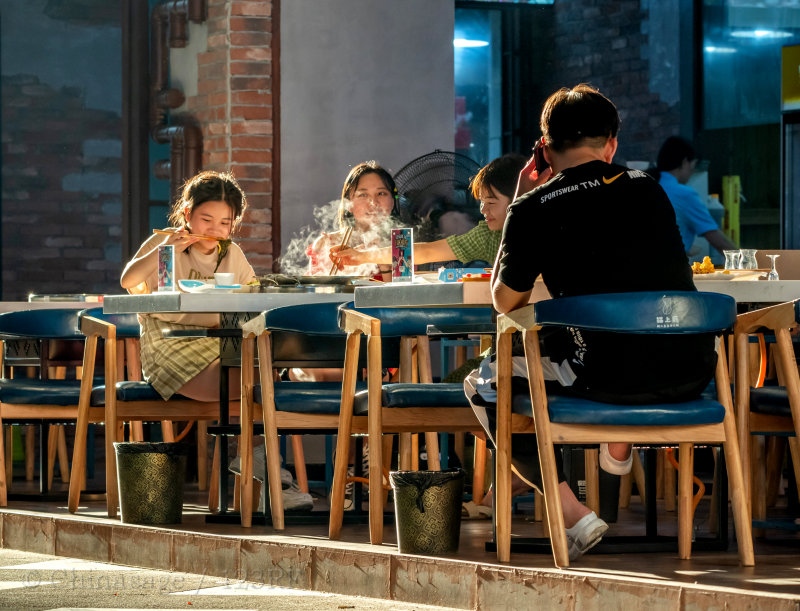
Food is very important in China as can be seen from the common greeting ‘Chi guo le ma 吃过了吗’ meaning ‘have you eaten yet?’. Another well known saying is ‘mín yǐ shí wéi tiān 民以食为天’ which roughly translates as ‘food is as important as the heavens above’.
Up until the last twenty years China was widely praised for its healthy diet and nutritional balance of food; since then the bad habits of western unhealthy foods have crept in and obesity ➚ is now a major health concern in China. In the last few decades international fast food outlets have conquered all the major cities.
Staple food
Traditionally the base of Chinese food has grain as the source of carbohydrate. In the north this comes from wheat in the form of noodles, dough and buns; in the south it comes from rice. This base is accompanied by several dishes of vegetables and meats often in a spicy sauce. Soybean curd is the protein source for vegetarians as an alternative to meat (it is known as Tofu in Japan; 豆腐花 Dòufǔhuā or 豆花 Dòuhuā in China). The meat and vegetables are cut up finely so they can be cooked quickly and picked up with chopsticks;. When there was little money for fuel it was important to cook quickly and efficiently. There is no tradition for eating large slabs of meat like beefsteaks or pork chops. Following the foundation of the PRC there were periods of shortages of food which led to famine, as late as the 1980s food coupons were issued to ration staple foods. The wok (this is the Cantonese pronunciation of cooking pot 镬 guō) is the universal and versatile cooking vessel. Compared to other eastern cuisines the style is for fresh foods with the addition of a few spices. Chinese cuisine has heavily influenced those of its neighbors: Japan, Korea, Vietnam and the Philippines.

A wide range of contrasting flavors are provided by sauces that may include ginger, soy sauce (made from fermented soybeans), sugar, garlic, spring onions and vinegar. Peppers and chillies are added in different amounts according to the regional cuisine; Sichuan province is known for its fiery peppers. Flavors are intended to contrast with the neutral taste of boiled rice and so spicy dishes should not be eaten on their own. Pork has generally been the most widely consumed meat particularly in the north; chicken and then beef are the next most common meats. A good meal should have diversity not just in flavors, colors and ingredients but in the method of cooking, so there should be something boiled, stir-fried, steamed and roasted.
Imported foods
Chinese cuisine has incorporated new foods as they became available from elsewhere in the world. With the opening up of China in the Tang dynasty spinach, almonds and lettuce made their way in from Central Asia. Sweetcorn, chillies, potatoes and squash arrived in the Ming dynasty with the creation of trading contacts with South America. In the last 100 years tomatoes have become a major part of the diet. Feeding 20% of the world's population on only 7% of the world's arable land has always been a great challenge.
Milk and dairy products were rare in China, indeed many Chinese can not digest them completely. Lactose intolerance has been measured at 90% of the population in Asia. With only limited agricultural land, cows are an inefficient way of producing food and this accounts for the small dairy industry. Traditionally the name for milk (奶 nǎi) was used for human mother's milk rather than from animals. The dairy rich diet of westerners has led Chinese people to report that westerner's skin smells like rancid milk. However in recent years, the dairy industry in China has grown considerably and dairy products are bought as luxury foods.
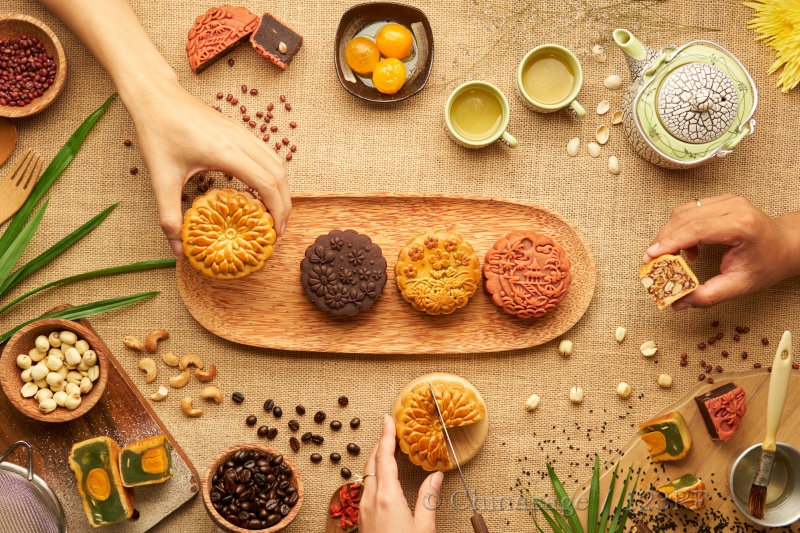
Snakes and bird's nests
With many disastrous famines in China over the centuries it is not surprising that the cooking of unusual animals and parts of animals takes place. There is also a long held belief that certain foods have medicinal benefits. Food has been always seen as not just sustenance but also medicine. So some foods are consumed for healthy living for instance mushrooms and noodles were believed to bring long life (noodles are rather long!) and snake meat for maintaining sharp eyesight. The balance of hot (spicy) and cool; meat and vegetable is tied up with the long held tradition of Yin and Yang. The various flavors and textures need to be balanced with their opposites, eating a meal of just one kind of food is intrinsically unbalanced. The tradition of many balanced dishes can make it difficult for vegetarians, despite the large number of Buddhists in the country, as some chefs find it hard to cook without using some sort of meat product.
There is also an aesthetic sense involved too, a good meal is not just about the sense of taste, color, texture and smell are carefully balanced as well. Foods will be added to compliment the balance of colors just as much as for taste. For some occasions the color of the dishes will have significance (yellow for new births; red for a wedding). A contrast in textures is often sought, so crispness is contrasted with smoothness. The order of dishes is important, duck should not precede or follow a chicken dish for example.
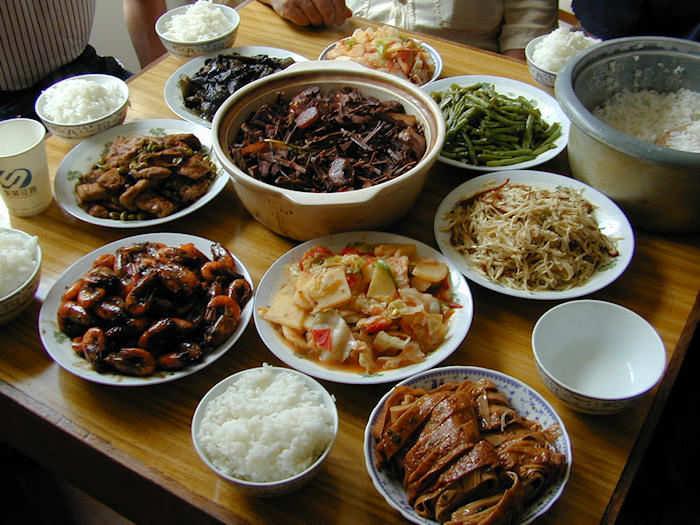
Categories of Food
To achieve a good diet a mixture of ‘hot’ (yang) and ‘cold’ (yin) foods must be cooked accounting for the season. The following lists give a rough guide to the relative ‘heat’ of a variety of foods.
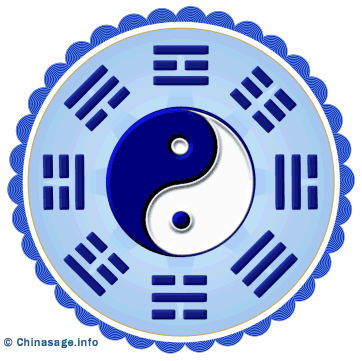
Hot foods (yang)
Beef steak; Butter; Chicken fat; Chillies; Chocolate sweets; Coffee; Fried noodles; Lamb; Lychee; Longan; Mango; Mustard; Onions; Peanuts; Pepper; Pork fat; Sesame seeds; Smoked fish; WhiskeyWarming foods
Abalone; Beef; Cheese; Chestnuts; Chicken liver; Chicken soup ➚; Eggs; Fennel; Garlic; Ginger; Goose; Green pepper; Guava; Ham; Kidney beans; Leeks; Liver; Milk Chocolate; Oyster sauce; Pomegranate; Pork meat; Potato; Pumpkin; Rabbit; Sausage; Spring onion; Sesame oil; Star anise; Sugar; Sunflower seeds; Tofu cheese; Turkey; Walnuts; Watermelon seeds; WineNeutral foods
Bean curd; Bread; Carrots; Cauliflower; Cherries; Chicken; Dates; Eggs; Flour (wheat); Frogs; Milk; Noodles; Peaches; Peas; Pigeon; Pine nuts; Plum; Pork ; Raisins; Red beans; Rice; Soup; Soy sauce; Soy bean oil; String beans; Tea (black and red)Cooling foods
Almonds; Apple; Asparagus; Bamboo; Barley; Beer; Bok choy; Broccoli; Cabbage; Celery; Cider; Coca Cola; Coconut; Corn; Duck; Eel; Fish; Grapes; Honey; Ice cream; Jellyfish; Lemonade; Lotus root; Lotus seeds; Melons; Millet; Mushrooms; Octopus; Oranges; Oysters; Persimmon; Pineapple; Pork offal; Pickled radish; Salt; Salted eggs; Sea cucumber; Seaweed; Spinach; Squid; Star apple; Strawberry; Sugar; Tofu; Tomato; Watermelon; YamsCold foods (yin)
Agar; Banana; Bean sprouts; Clams; Coconut milk; Crab; Cucumber; Dried Chinese mushrooms; Hawthorn; Kelp; Loofah; Mint leaves; Mussels; Mung beans; Pears; Shrimp; Snake; Soda water; Soy bean milk; Green TeaAs well as the relative 'heat' of foods the nutritional value of food is important particularly when caring for the ill.
Strongly nourishing
Bird's nest; Black dates; Free range Chicken; Chicken soup; Herbal wines; Pigeon; Pork offal; Ginseng teaModerately nourishing
Beef; Carp; Chicken; Dates; Duck; Eel; Eggs; Fish roe; Frogs; Lamb; Oxtail; Pork offal; Rabbit; Sea cucumber; Shark's fin; Snakes; TurtlesLightly nourishing
Abalone; Beef steak; Black bean; Carrots; Dried mushroom; Duck egg; Garlic; Honey; Jellyfish; Kidney beans; Lamb offal; Lotus seeds; Milk; Pork meat; Scallops; Sesame; Spinach; Wine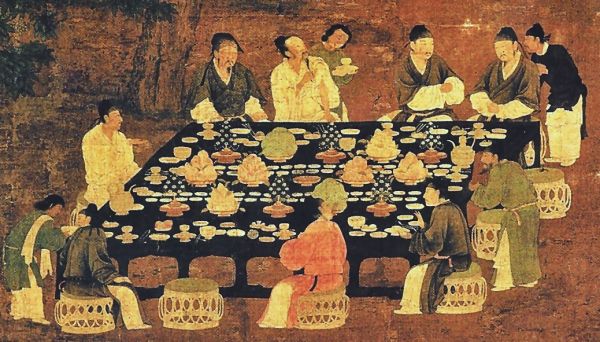
History of eating in China
In China, traditions go back a very long way, the etiquette of eating gets a mention in the Analects of Confucius (c. 500BCE) in chapter ten Confucius writes of the virtuous man's approach to food:
“He did not eat rice which had been injured by heat or damp and turned sour, nor fish or flesh which has gone off. He did not eat what was discolored, or what had a bad flavor, nor anything which was badly cooked, nor out of season.
He did not eat meat which was not correctly cut, nor what was served without its proper sauce.
Though there might be a large amount of meat, he would not exceed the due proportion for the rice.
It was only in wine that he laid down no limit for himself, but he did not allow himself to be confused by it.
He did not partake of wine and dried meat bought at the market.
He was never without ginger when he ate. He did not eat much.
When eating, he did not converse. ”
From Analects of Confucius ➚
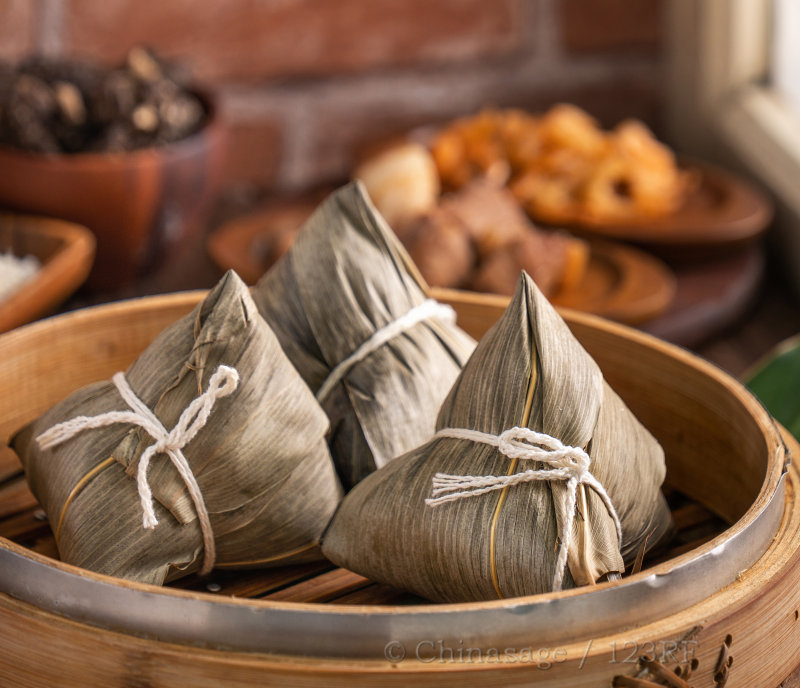
The Lǚshì Chūnqiū 吕氏春秋 (an encyclopedia written c.240BCE) identifies five flavors: sweet, sour, bitter, spicy and salty. The five flavors are each associated with one of the five elements of Chinese tradition: earth, wood, fire, metal and water respectively; each flavor is associated with a particular season of the year. The book describes nine different methods of boiling and it was considered that the transformation of flavors during cooking is ‘beyond all knowledge’. In Ancient China millet in the north and rice in the south were the basic ‘grain food’ 饭 fàn combined with vegetables 菜 cài. Much later many foods from Central Asia arrived during the cosmopolitan Yuan era including Sorghum, wheat, broad beans and alfalfa. When the Spanish started trading in the Ming dynasty more exotic foods came from America including chilli peppers, maize, sweet potatoes, potatoes, tomatoes. It is hard to imagine how Chinese food would have tasted without these new ingredients.

A formal Chinese Banquet
A traditional welcome for a guest is a lavish banquet of ten or more dishes. The banquet often starts with a drink of tea with the host sitting at the head of the table with the chief guests on either side. The eldest guests are seated first. Sometimes the host will start by serving the guests, you should wait for the host to give the signal to start eating. It is rude to arrive late, if applauded on entry it is customary to applaud back in response. Traditionally the first food will be cold starters: vegetables, eggs and pickled meats. The following main course is a large selection of dishes. People help themselves from central serving dishes and eat with chopsticks.
Originally all would be seated around small tables with a central space reserved for entertainers to perform during the meal. Formal invitations would be sent out maybe three times to remind people of the event. The most lavish banquets were at the Imperial court and only the privileged few were invited. The Manchu-Han Imperial Feast (满汉全席 mǎn hàn quán xí) consisted of 108 dishes split into 6 banquets spread over 3 days. Dishes and chopsticks were of gold and some of the more exotic items included monkey brain, rhinoceros tail and bear claw. It has become a metaphor for a particularly lavish feast.
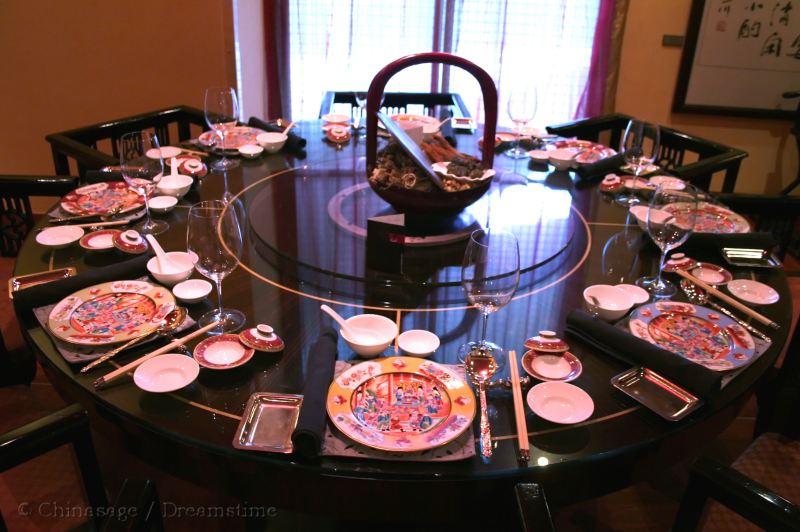
Table etiquette
A lot of food may be left over at the end of the meal, as an empty dish suggests the host has not provided enough food and the guest remains hungry. Most dishes include both meat and vegetables, some have only vegetables and there are usually some fish dishes. The flavors are designed to complement and harmonize so there are some spicy, some sour and some sweet. Large amounts of boiled rice are served later on in the meal after the flavors of the main dishes have been savored and the meal becomes more a question of filling the stomach. Rice never forms a complete meal by itself. An informal meal will have rice served at the same time as the main dishes but the food ordered should bear in mind sharing rather than choosing for personal favorites. In China, a thin soup is served sometimes in the middle and at the end of the meal to help calm the stomach. There are very many fine, thin, clear soups to choose from. China has only a few traditional desserts but a great range of fruit is available instead. Finally, warmed towels are often provided to wipe the hands and face.
Chopsticks 筷子 Kuài zi
Chopsticks have served as a natural extensions of the fingers since the Zhou dynasty (3,000 years ago). They used to be made of wood but now are more common in plastic, many people carry their own chopsticks with them for eating out. Food is always finely chopped and shredded so it can be picked up with them. However rice is eaten by bringing the bowl to the mouth and then shoveling it with the chopsticks. The use of chopsticks is widespread throughout south-east Asia and not just in China. They are typically 8 inches [20 cms] long. They are held between the thumb and fingers of one hand and are used like tongs to pick up individual morsels of food. There are several rules of etiquette for chopsticks. They should not be lent to other people. They should be placed neatly on the table, not on plates and not used as drumsticks for banging on dishes. They should never be placed upright in a bowl of rice as that is part of the ancestral ceremony to welcome in spirits. Chopsticks are a common gift at weddings where they symbolizes the hope for newlyweds to have children quickly because kuaizi sounds the same as 快子 ‘fast sons’. There is also the similar sounding 块 kuài which is a colloquial term for money so they can symbolize wish for wealth.
Traditionally people eat noisily and take care to serve their neighbors making sure the best bits are shared around equitably. It is impolite to refuse an offered dish, it should at least be tasted. Alcohol at formal meals is normally drunk as a series of toasts. Originally ceramic bowls rather than glasses were used for drinks. A call of ‘Gānbēi 干杯’ meaning literally ‘empty glass’ is called when a toast is to be drunk. Green Tea is often drunk during the meal and it is expected that you serve tea for your neighbors. The spout of the teapot should not be left pointing directly at anybody. To indicate thanks it is traditional to tap fingers on the table, this goes back to a story of the Emperor Qianlong who when he visited restaurants in disguise, his attendants when served by the Emperor would have normally kowtowed in thanks used the finger tapping gesture instead. At the end of the meal the host may stand at the door personally wishing each guest farewell ‘Zai jian’.
Regional cuisines - 1: Northern China
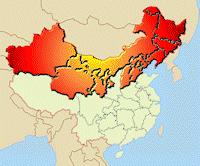
Steamed meat or vegetables wrapped in dough (Jiaozis ➚ 饺子) are popular in the north (see here for a recipe - they are particularly popular at the Spring Festival). Similarly there are meat filled steamed bread snacks - Baozi ➚ 包子. Breakfast in the north is traditionally just rice porridge with pickled vegetables. Some dishes include chilli peppers to help keep out the winter cold. The range of food available is rather less than in the south. The port city of Tianjin with its long history shows the influence of Russian and Japanese cuisine. Dishes include: ‘Drunken Empress Chicken’ - inspired by Yang Guifei with lashings of Shaoxing spirit. ‘Phoenix Tail Prawns’ where the tail is battered and deep fried. ‘Lamb in Sweet Bean Sauce’ the classic sweet and sour sauced dish. ‘Hot Candied Apples’ - a simple dessert and ‘Mandarin fish’ a fish and wine dish wrapped up in pig's intestine.
Inner Mongolia is famous for lamb dishes, ‘Mongolian hotpot’ is sliced lamb with vegetables and noodles. ‘Shanxi Tounao’ is a thick soup of mutton; lotus; yam; herbs and rice wine. Shanxi is also famous for its noodles, stretched so long that the noodles can be as fine as hair. ‘Mongolian’ stews also feature. These dishes show the influence of nearby Mongolia . A form of jiaozi called ‘Shumai’ are steamed stuffed dumplings made from wheat flour and filled with ground pork.
Beijing cuisine
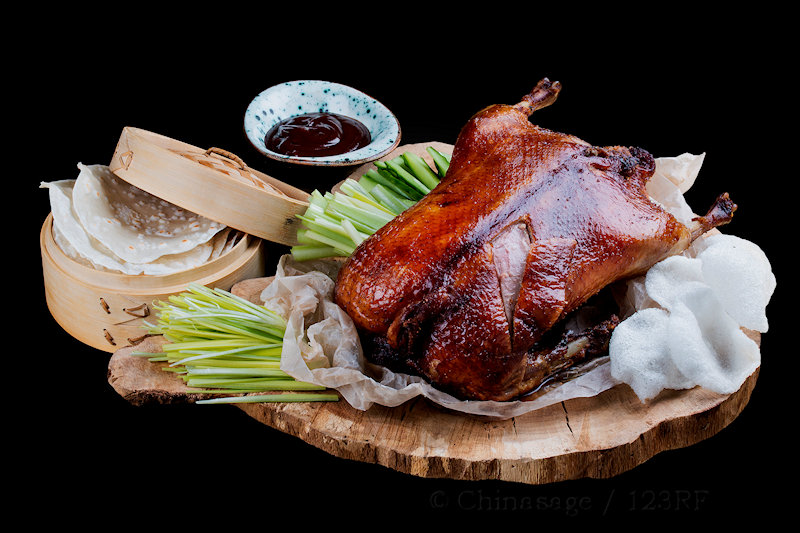
Beijing as the Imperial capital could afford to import many luxury foods. Shark's fin, Bird's nest, Peking duck and Abalone are amongst the best known. ‘Peking Duck’ was an Imperial treat, the locally raised ducks are dried and brushed with a sweet marinade. It is served with pancakes, cucumbers and onions with a sweet plum sauce. The Quanjude ➚ restaurant in Beijing is the most famous and popular place to go to eat the duck, where it can be seen being smoked from a fire of peach wood. Tradition has is that the local ducks grew fat from the spilled grain from boats bringing the food from southern China on the Grand Canal. The ducks are also used to produce liver pate. During the 70s and 80s large piles of cabbages were a common sight of winter in Beijing. Cabbages keep for long periods and are not harmed by the severe cold. In those days of centralized agricultural planning there was little choice of food - just the necessary staples.
Shandong cuisine

Shandong (Lu cuisine) has a very ancient tradition of cooking and by many is regarded as the oldest and best. ‘Sweet and Sour Carp’ is a famous dish traditionally made with local Yellow River carp. ‘Bird's Nest Soup’ made of swallow saliva is a prized delicacy. ‘Scallion Lamb’ is another well known dish.
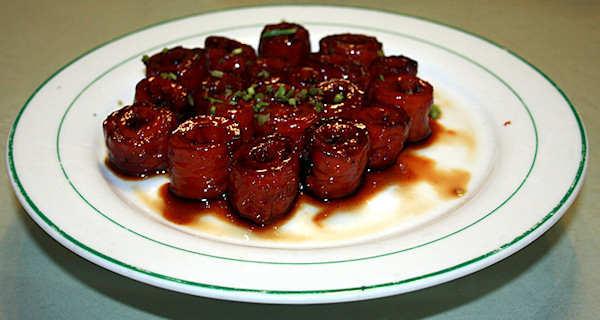
Regional cuisines - 2 Eastern-Central China
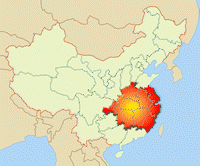
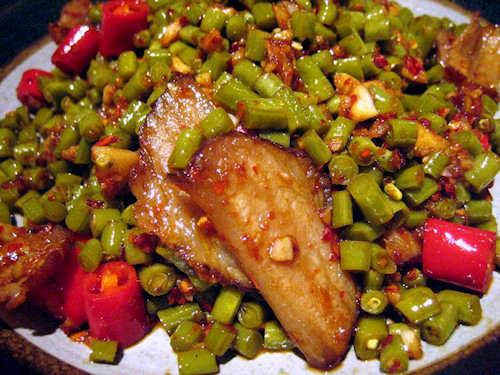
For centuries the rivers and mild climate of Central China have made it the land of fish and rice. Shanghai's cuisine comes from many sources and is famous for fish dishes such as ‘Hairy Crab’. It is noted for good vegetarian (Buddhist) restaurants. Generally the cuisine is a bit sweeter than other areas and a bit heavier as more oil is used. Hunan dishes can be hot, even hotter than Sichuan. Famous dishes include ‘Farmer Style Pork’ and ‘Fish Head with Chopped Chilli’, Nanjing as an Imperial capital has many dishes including ‘Beggar's Chicken’ (a whole chicken stuffed with herbs and vegetables and wrapped in clay and cooked). The story of the dish is that originally a chicken stolen from the Emperor's kitchens was buried in order to conceal it. Other dishes include: ‘Lion's Heads’ - Pork meatballs braised with vegetables (Jiangsu); ‘Tofu casserole’ - Bean curd with sea cucumbers, mushrooms, bamboo shoots; ‘Squirrel Fish’ - A deep fried battered bream served with sweet and sour sauce; ‘Three layer Shreds’ - Shredded ham; chicken; pork with bamboo shoots and black mushrooms; ‘Eight Treasure Buddha’ - Vegetarian dish with many ingredients; ‘Sweet and Sour Spare Ribs’ - Pork rib meat in bite sized chunks
The province of Anhui is noted for white bamboo shoots much used in vegetarian dishes with mushrooms. Jiangsu province (Su) cuisine emphasizes fresh ingredients with sweet and salty flavors. Zhenjiang, Jiangsu produces 'Chinkiang (aka Zhenjiang) vinegar' - a black rice vinegar. Fujian province (Min) cuisine is famous for soups, and flavors that are subtle and light. ‘Fish Ball’ and ‘Buddha Jumps Over the Wall’ (named after a Buddhist monk who could not resist the fine aroma of the dish), are well known dishes as well as ‘Sour Mustard Beef’. Zhejiang province (Zhe) cuisine is fairly similar to Min cuisine - it has a fairly light style and is artistically presented. The city of Jinhua, Zhejiang is famous for hams. ‘Dongpo Pork’ is a favorite dish of Hangzhou named in honor of the Song poet Su Dongpo (Su Shi).
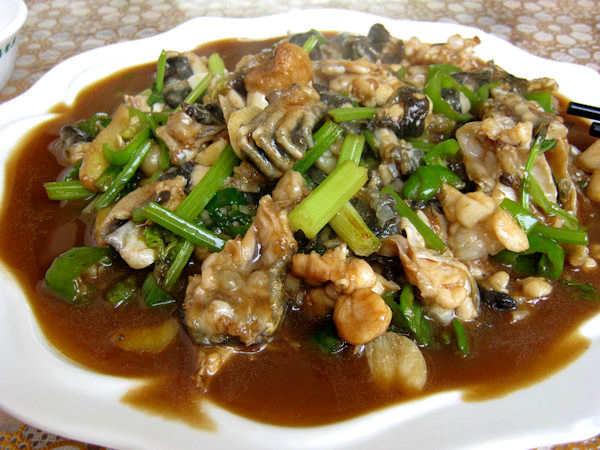
Regional cuisines - 3 Cantonese Southern cuisine
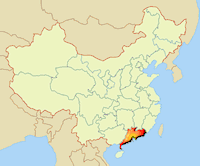
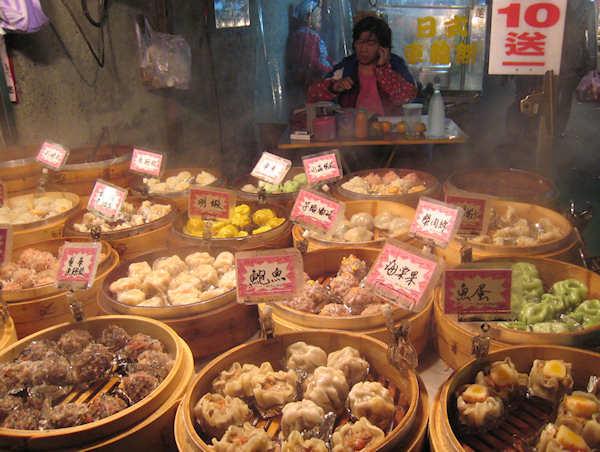
Guangdong province in southern China is known for shellfish and fish cuisine. The world famous ‘Cantonese Cuisine’ is named after ‘Canton’ the old spelling for Guangzhou the provincial capital. Perhaps best known is Dimsum, Dimsum literally means ‘dot on the heart’ (点心 diǎn xin) which is a way of saying ‘light on the stomach’, it is boiled dough with a variety of spicy and savory fillings; it is a form of the more general ‘little eats’ (小吃 xiǎo chī) common all over China; quite often for breakfast. Cantonese cuisine involves a lot of steaming and boiling; it is less spicy than the other cuisines and also lower in oils and fats. A wide range of sauces are used including Hoisin sauce (based on soya and chillies). A common dish is ‘Cantonese Barbecue Pork’ char siu or (叉烧 chā shāo), another is the well known 'Spring Rolls' where vegetables or meat are wrapped in a pancake. Due to the migration of many Chinese people away from this region there are more Cantonese restaurants around the world than any other style of Chinese cuisine. A large number of Cantonese words for food have found their way into English: Bok choy, Chop suey, Dimsum, Longan, Loquat, Lychee, Shumai, Wok and Wonton.
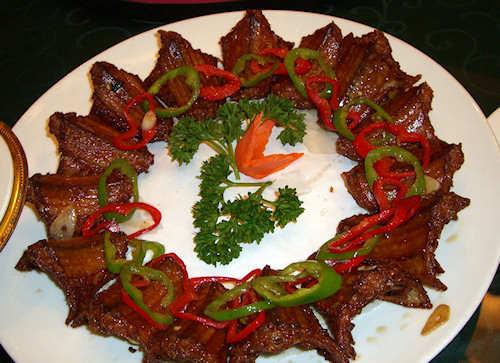
Very exotic foods like Thousand Year Old Eggs ➚, cats, snakes, dogs are restricted to the far southern provinces of Guizhou, Guangdong and Guangxi. ‘Dragon Duel Tiger’ is the name of an unusual mix of snake and cat meat. Further east in Guangdong province, Chaozhou has a rich cuisine with many fish and salty dishes. Hong Kong has a very wide range of cuisines with little distinctly special; reflecting its position as a cosmopolitan trading port. Macau retains quite a few Portuguese dishes in its cuisine from its time as a colony.
Regional cuisines - 4 Western China
Sichuan cuisine
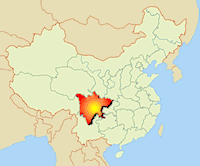
Sichuan (or Chuan) province cuisine is known for fiery food from its liberal use of chillies and peppers. A dish associated with the poet Du Fu is 麻婆豆腐 má pó dòu fǔ literally ‘soya bean curd of the pock marked old woman’. Spiciness may have been introduced to counteract high humidity but many dishes are not ‘hot’ at all. Subtle use of chillies is made to promote the appreciation of the other flavors. Sichuan is famous for preserved, pickled vegetables such as mustard root. Hot pot cookery ‘火锅 huǒ guō particularly in Chongqing, uses a pot of heated chilli and Sichuan pepper sauce for diners to dip food into. Frog’s legs, aubergines and smoked duck are other specialties. The local ‘Aromatic Crispy Duck’ is prepared in a different way to the more famous ‘Peking duck’. Another local specialty is ‘Twice Cooked Pork’ where the meat is first boiled and then stir fried for tenderness. ‘Toban Fish’ is a deep fried fish dish with a rich sauce. Finally another dish to savor in Sichuan is ‘Steamed Chicken with Chili Sauce’.
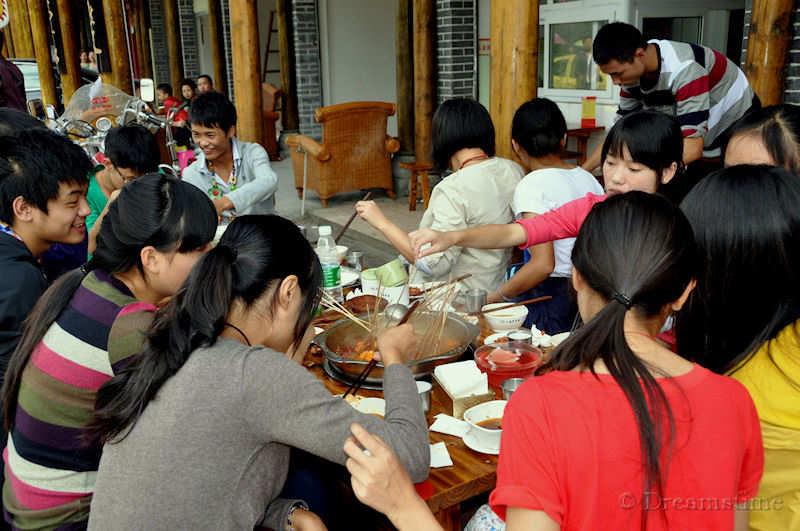
Yunnan cuisine
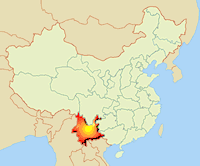
The province of Yunnan in south-western China has many more vegetable dishes reflecting the strong local influence of Buddhism. There is the famous ‘Cross Bridge Rice Noodle’ dish which is a hot soup with a sealing layer of hot oil into which meat and vegetables are dropped in for quick cooking at the table. The tropical climate allows many exotic fruits, fungi and vegetables to be grown and used in cooking. Reflecting the mountainous terrain in Yunnan, suitable for little else than grazing, this is the one province in China where dairy products are widely used in cookery.